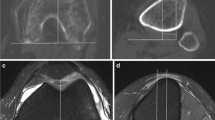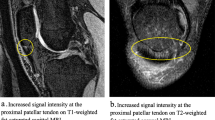Abstract
Purpose
The purposes of this study are to, firstly, develop techniques to accurately identify extensor mechanism malalignment by measuring the alignment of the quadriceps tendon (QTA) with computerized tomography (CT) scans. Secondly, to investigate correlations between QTA and lower limb bony anatomical variations within a representative normal population. Lastly, to evaluate the clinical significance of QTA by establishing its potential connection with lateral facet patellofemoral joint osteoarthritis (LFPFJOA).
Method
CT scans were orientated to a mechanical axis reference frame and three techniques developed to measure the alignment of the quadriceps tendon. Multiple measurement of bony alignment from the hip to the ankle were performed on each scan. A series of 110 cadaveric CT scans were measured to determine normal values, reproducibility, and correlations with bony anatomy. Secondly, a comparison between 2 groups of 25 patients, 1 group with LFPFJOA and 1 group with isolated medial OA and no LFPFJOA.
Results
From the cadaveric study, it was determined that the alignment of the quadriceps tendon is on average 4.3° (SD 3.9) varus and the apex of the tendon is 9.1 mm (SD 7.7 mm) lateral to the trochlear groove and externally rotated 1.9° (SD 12.4°) from the centre of the femoral shaft. There was no association between the quadriceps tendon alignment and any other bony measurements including tibial tubercle trochlear groove distance (TTTG), coronal alignment, trochlear groove alignment and femoral neck anteversion. A lateralized QTA was significantly associated with LFPFJOA. QTA in the LFPFJOA group was 9.6° varus (SD 2.8°), 21.3 mm (SD 6.6) lateralised and 17.3° ER (SD 11°) compared to 5.5° (SD 2.3°), 10.7 mm (SD 4.9) and 3.3° (SD 7.2°), respectively, in the control group (p < 0.001). A significant association with LFPFJOA was also found for TTTG (17.2 mm (SD 5.7) vs 12.1 mm (SD 4.3), p < 0.01). Logistic regression analysis confirmed the QTA as having the stronger association with LFPFJOA than TTTG (AUC 0.87 to 0.92 for QTA vs 0.79 for TTTG).
Conclusion
These studies have confirmed the ability to accurately determine QTA on CT scans. The normal values indicate that the QTA is highly variable and unrelated to bony anatomy. The comparative study has determined that QTA is clinically relevant and a lateralised QTA is the dominant predictor of severe LFPFJOA. This deformity should be considered when assessing patella maltracking associated with patella osteoarthritis, patella instability and arthroplasty.
Level of evidence
III (retrospective cohort study).





Similar content being viewed by others
References
Ferri R, Digennaro V, Panciera A, Bulzacki Bogucki BD, Cecchin D, Manzetti M et al (2023) Management of patella maltracking after total knee arthroplasty: a systematic review. Musculoskelet Surg 107(2):143–157
Hinman RS, Crossley KM (2007) Patellofemoral joint osteoarthritis: an important subgroup of knee osteoarthritis. Rheumatology 46(7):1057–1062
Maine S, O’Gorman P, Barzan M, Stockton CA, Lloyd D, Carty CP (2019) Rotational malalignment of the knee extensor mechanism. Defining rotation of the quadriceps and its role in the spectrum of patellofemoral joint instability. JBJS Open Access 4(4):1–7
Mizuno Y, Kumagai M, Mattessich SM, Elias JJ, Ramrattan N, Cosgarea AJ et al (2001) Q-angle influences tibiofemoral and patellofemoral kinematics. J Orthop Res 19(5):834–840
Momoli A, Modena M, Giaretta S (2013) Extensor mechanism realignment procedures in the treatment of patellofemoral instability. Joints 1(2):21–26
Skouras AZ, Kanellopoulos AK, Stasi S, Triantafyllou A, Koulouvaris P, Papagiannis G et al (2022) Clinical significance of the static and dynamic Q-angle. Cureus. https://doi.org/10.7759/cureus.24911
Nisar S, Palan J, Rivière C, Emerton M, Pandit H (2020) Kinematic alignment in total knee arthroplasty. EFORT Open Rev 5(7):380–390
Shatrov J, Battelier C, Sappey-Marinier E, Gunst S, Servien E, Lustig S (2022) Functional alignment philosophy in total knee arthroplasty - rationale and technique for the varus morphotype using a CT based robotic platform and individualized planning. SICOT J. https://doi.org/10.1051/sicotj/2022010
Fulkerson JP (1983) Anteromedialization of the tibial tuberosity for patellofemoral malalignment. Clin Orthop Relat Res 177:176–181
Wilkens OE, Hannink G, van de Groes SAW (2020) Recurrent patellofemoral instability rates after MPFL reconstruction techniques are in the range of instability rates after other soft tissue realignment techniques. Knee Surg Sports Traumatol Arthrosc 28(6):1919–1931
Marquez-Lara A, Andersen J, Lenchik L, Ferguson CM, Gupta P (2017) Variability in patellofemoral alignment measurements on MRI: influence of knee position. AJR Am J Roentgenol 208(5):1097–1102
Ormeci T, Turkten I, Sakul BU (2022) Radiological evaluation of patellofemoral instability and possible causes of assessment errors. World J Methodol 12(2):64–82
Kellgren JH, Lawrence JS (1957) Radiological assessment of osteo-arthrosis. Ann Rheum Dis 16(4):494–502
Hochreiter B, Hirschmann MT, Amsler F, Behrend H (2019) Highly variable tibial tubercle-trochlear groove distance (TT-TG) in osteoarthritic knees should be considered when performing TKA. Knee Surg Sports Traumatol Arthrosc 27(5):1403–1409
Hosmer DW, Lemeshow S (2000) Applied logistic regression, 2nd edn. John Wiley and Sons, New York, NY, pp 160–164
Balcarek P, Jung K, Frosch KH, Stürmer KM (2011) Value of the tibial tuberosity-trochlear groove distance in patellar instability in the young athlete. Am J Sports Med 39(8):1756–1761
Berruto M, Ferrua P, Carimati G, Uboldi F, Gala L (2013) Patellofemoral instability: classification and imaging. Joints 1(2):7–14
Haj-Mirzaian A, Guermazi A, Hakky M, Sereni C, Zikria B, Roemer FW et al (2018) Tibial tuberosity to trochlear groove distance and its association with patellofemoral osteoarthritis-related structural damage worsening: data from the osteoarthritis initiative. Eur Radiol 28(11):4669–4680
Tsavalas N, Katonis P, Karantanas AH (2012) Knee joint anterior malalignment and patellofemoral osteoarthritis: an MRI study. Eur Radiol 22(2):418–428
Camathias C, Rutz E, Brunner R, Vavken P, Gaston M (2014) Poor outcome at 7.5 years after Stanisavljevic quadriceps transposition for patello-femoral instability. Arch Orthop Trauma Surg 134(4):473–478
Eckhoff D, Hogan C, DiMatteo L, Robinson M, Bach J (2007) Difference between the epicondylar and cylindrical axis of the knee. Clin Orthop Relat Res 461:238–244
Iranpour F, Merican AM, Baena FR, Cobb JP, Amis AA (2010) Patellofemoral joint kinematics: the circular path of the patella around the trochlear axis. J Orthop Res 28(5):589–594
Iranpour F, Merican AM, Dandachli W, Amis AA, Cobb JP (2010) The geometry of the trochlear groove. Clin Orthop Relat Res 468(3):782–788
Talbot S, Dimitriou P, Radic R, Zordan R, Bartlett J (2015) The sulcus line of the trochlear groove is more accurate than Whiteside’s line in determining femoral component rotation. Knee Surg Sports Traumatol Arthrosc 23(11):3306–3316
Acknowledgements
None applicable
Funding
None applicable.
Author information
Authors and Affiliations
Contributions
ST designed the study, collected data and wrote the manuscript. RZ analysed data and wrote the manuscript. KB collected data and wrote the manuscript. FS collected data and wrote the manuscript. AG collected data and wrote the manuscript. NW designed the study and wrote the manuscript. BW designed the study and wrote the manuscript. All authors read and approved the final manuscript.
Corresponding author
Ethics declarations
Conflict of interest
None applicable.
Ethical approval
Ethics approval was sought and gained from the Victorian Institute of Forensic Medicine (VIFM) (EC10-2019) and by St Vincent’s Health Network (HREC/18/SVH/250).
Informed consent
Informed consent was obtained from all participants in in the cohort study.
Additional information
Publisher's Note
Springer Nature remains neutral with regard to jurisdictional claims in published maps and institutional affiliations.
Rights and permissions
Springer Nature or its licensor (e.g. a society or other partner) holds exclusive rights to this article under a publishing agreement with the author(s) or other rightsholder(s); author self-archiving of the accepted manuscript version of this article is solely governed by the terms of such publishing agreement and applicable law.
About this article
Cite this article
Talbot, S., Zordan, R., Bennett, K. et al. Quadriceps tendon malalignment is an independent anatomical deformity which is the primary abnormality associated with lateral facet patellofemoral joint osteoarthritis. Knee Surg Sports Traumatol Arthrosc 31, 5950–5961 (2023). https://doi.org/10.1007/s00167-023-07661-z
Received:
Accepted:
Published:
Issue Date:
DOI: https://doi.org/10.1007/s00167-023-07661-z




